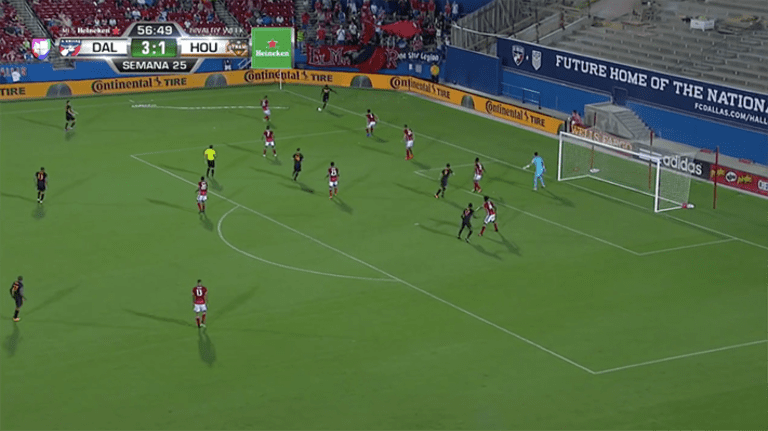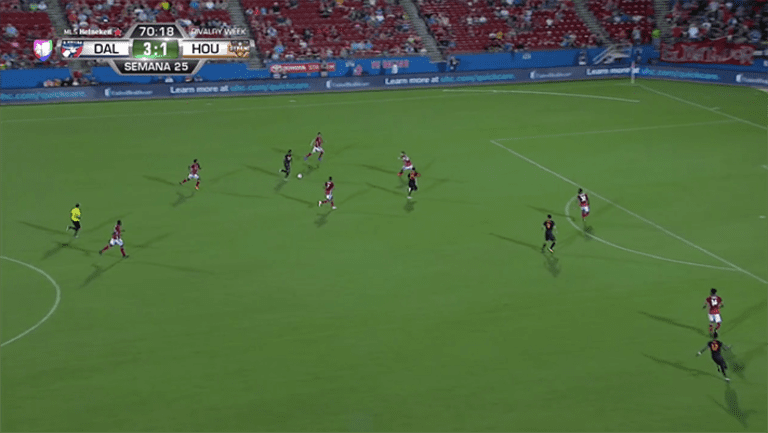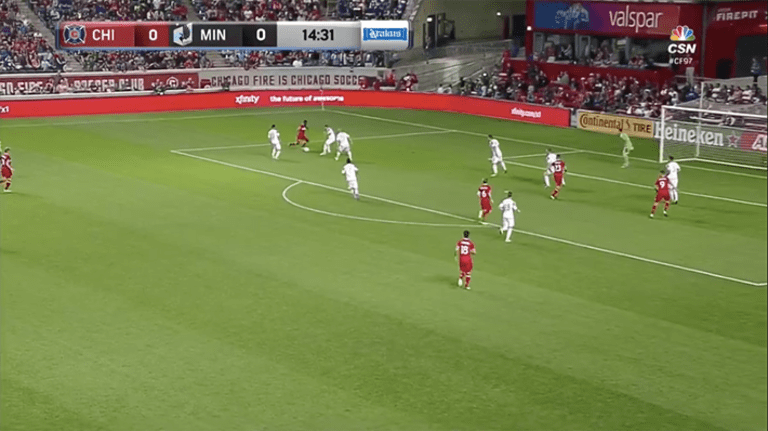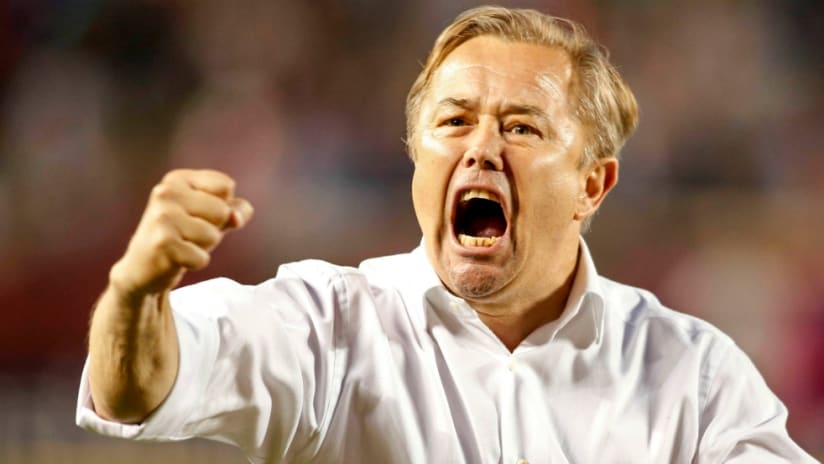Each week, Sam Polak breaks down the top coaching moves in MLS from the previous week. Here are his top five from Week 25.
5. Petke’s RSL leave nothing to doubt against Quakes
With his Real Salt Lake up a goal and a man after a red card to San Jose Earthquakes’ Anibal Godoy in their Wednesday night clash, it would have been easy for Mike Petke to have his team take its foot off the gas. RSL could have simply looked to just knock the ball around with their man advantage, picking and choosing moments to go forward while prioritizing their 1-0 lead.
Instead of just seeing the game out or maintaining possession in order to force San Jose to have to chase the game, Petke let his team stay on the front foot and it proved to be the right call.
RSL hit the post within 90 seconds of the ejection, they scored their second goal in the 68th, their third in the 80th and then one more time in the 93rd— finishing the game 4-0. This performance also allowed RSL to come into their weekend matchup against Colorado full of confidence and their 4-0 win likely had a hand in their continued excellence, as they took down the Rapids 4-1.
4. Houston pull out a draw in Frisco
The Houston Dynamo ended up with a 3-3 draw against FC Dallas in their midweek contest. Had it not been for Wilmer Cabrera’s clever adjustments during the last 35 minutes however, the Dynamo would have likely walked away with no points to show for their effort.
After going down 3-1 in the 52nd minute, Cabrera brought on Romell Quioto three minutes later and simultaneously swapped formations from a 4-3-3 to essentially a 4-2-4. This change in personnel and in system did a couple things for the Dynamo.
First, though, Houston had to defend with six players (which was at times a tough ask), keeping four players high allowing them several passing options to escape their defensive third once they were able to take back control of possession from Dallas. Second, the tactical adjustment meant Houston always had at least three players as attacking options whenever the Dynamo were going forward from out wide or centrally.
Committing an additional player into the attack was immediately visible. Within minutes of Quioto entering the match, he ended up pulling out wide but Houston still had three supporting players waiting in the box for a cross as see below instead of the two they would have had earlier.

Though these very shifts in dynamics didn’t result in a goal above, they were the catalyst behind the Dynamo’s crucial second goal. The image below shows exactly how they were able to find the net via Cabrera’s tweaks: Quioto, after receiving an outlet pass from the defensive third, was able to drive forward with three additional Dynamo players already waiting to join the attack. And after playing a simple pass forward, Erick Torres tucked the ball away.

A similar commitment from the four attackers created the third goal for Houston as well. Torres, Quioto and Tomas Martinez worked as the three players waiting for their chance to capitalize off of the fourth attacker— Mauro Manotas’ effort towards goal, which Torres again put past Dallas’ Jesse Gonzalez.
3. Tata Martino makes the right subs
Despite going up a man in the 52nd minute because of a red card to the Philadelphia Union's Joshua Yaro and being down a goal in the match at that time, Atlanta United spent the next seven minutes playing some very underwhelming soccer— especially given the circumstances of their hunting for the final Audi 2017 MLS Cup Playoffs spot in the Eastern Conference.
It was at this time Atlanta head coach Tata Martino made one of a couple substitutions that were the major driving force behind his side ultimately coming away with a point in a 2-2 draw against the Union.
In the 59th minute, Martino made the bold decision to insert attacking-minded midfielder Julian Gressel for center back Michael Parkhurst. This provided a much-needed spark for what had been flat-footed Atlanta side.
Gressel’s introduction into the game brought about an almost immediate uptick in the pace of Atlanta’s play. They nearly scored off a quick restart within two minutes of his arrival, were more incisive passing into further threatening spaces and showed a greater desire to find a way to take advantage of playing 11-v-10.
With the attacking energy Gressel provided, Atlanta created a number of dangerous opportunities. But it took until the 91st minute when fellow substitute Tyrone Mears, whom Martino had put in just 15 minutes before, got the well-deserved game-tying goal for Atlanta.
2. Toronto impress in a different shape
Toronto FC has showed they can get the job done in more than one formation when they dismantled the Union on Wednesday night without coming out in a 3-5-2. Greg Vanney’s decision to play a 4-4-2 with Victor Vazquez at the top of a midfield diamond is a move that the rest of the league will have definitely noted and we could see again in the future.
Setting up in this way, Vanney allowed Vazquez, the league leader in assists and arguably the best passer in MLS, to roam dangerous central zones of the pitch more often than when TFC play their 3-5-2. And moreover, from these central parts of the field, Sebastian Giovinco and Jozy Altidore have the maximum amount of space to play off the Vazquez while still consistently remaining within striking distance of opponents’ goals once they receive such passes.
This 4-4-2 saw Vazquez earn two assists— but you really could give him a third as it was his pass to Giovinco in the ninth minute that led to the Giovinco’s free-kick goal.
Though TFC went back to their usual shape against Montreal over the weekend, bringing back this tactical dimension to Toronto’s already devastating offense will be something to keep an eye on with the playoffs around the bend.
1. Minnesota’s defense holds firm in Chicago
On August 20, Minnesota United FC went into Seattle a significant underdog and the Loons nearly stole a point on the road with one of their best defensive outings all season. Traveling to take on the Chicago Fire this weekend, Adrian Heath had his team build on that quality defensive performance, and it paid dividends for them as they took down the Fire 2-1.
It wasn’t that Minnesota United had a particularly special scheme when they weren’t in possession. It was simply that Heath had his side equipped to play solid, methodical defense throughout the majority of the 90 minutes.
This can be seen in a number of moments during the match.
Minnesota were completely locked in on the threatening runs of David Accam, closing him down with three players at time and doing so without providing an easy escape route via pass or dribble like the one below.

Minnesota’s commitment to covering the full width of the pitch stood out as well. They can be seen below collectively tracking from one side of the field to the other shutting down Chicago’s ability to switch the point of attack as a means to progress — and then even winning the ball back with an impeccable tackle.
And there were moments like the one below where the Loons simply refused to make anything easy for Chicago:
Given situations like these, it was no fluke Minnesota only allowed three shots on target outside the one goal they conceded. What’s more, of these three shots on goal, none truly presented a challenge to goalkeeper Bobby Shuttleworth because of the defense in front of him.
When all is said and done, there are of course nuances and tactical wrinkles that can be applied to defending. However, the subtleties of defending are worthless without three things: discipline, effort and willingness to cover for teammates. As Minnesota have little to no chance of making the playoffs, Heath and his coaching staff deserve a ton of credit for getting the necessary level of dedication and pride in their side’s defense to earn arguably the best win of their inaugural MLS season.











